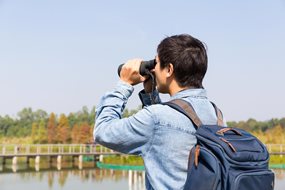By Elaine Stevens

It’s been said that in order to witness the beauty and diversity of the birds and wildlife of South Mississippi, you must become part of the silence. Our One Coast has many agencies, organizations, and naturalists who do just that and much more in educating and preserving our ecology. Thanks to their efforts, witnessing that part of Nature’s wonders in South Mississippi can you lead you on adventures many visitors will never experience.
A complete and centralized location for a variety of birding and conservation activities, including field trips and resources, is the Pascagoula River Audubon Center in Moss Point. There you will also find details about the Mississippi Coast Audubon Society (MCAS). The MCAS’s popular project "Nest in Peace,” dating back to 1975, initiated its charter the following year. Today it is the state’s largest Audubon chapter. Visit http://www.pascagoulariver.audubon.org and www.mscoastaudubon.org.
One cannot be a birding enthusiast in South Mississippi—or elsewhere, for that matter—and not utter the name of Judith Toups, founder of the MCAS. Responsible for many of the high profile protection programs in place today for terns and black skimmers, Toups also developed the Mississippi Coastal Birding Trail map, authored two books on Gulf Coast birding, and has been honored by many birding societies. In fact, we recommend a visit to the Judith Toups Least Tern Highway, dedicated in early 2008, and located in Gulfport bordering the nesting areas she sought to protect. Though Toups passed away several years ago, her birding blog, titled "A Year with Judy Toups,” is alive and well. Containing an archive of Toup’s weekly articles, it is a must read for the avid enthusiast.
Because the Gulf Coast is a flyway (a route regularly used by a large number of migrating birds), one is able to see birds here in the fall and spring that aren’t indigenous to the area year round. Backyards are a popular birding location for resident birders. Of course shorebirds, like pelicans and gulls, are in abundance coastwide.
Here are just a few of the locations within the tri-county area of Hancock, Harrison, and Jackson Counties and a sampling of what you may discover:
• The Barrier Islands – Cat, Deer, Horn, Petit Bois, and Ship:
Osprey, American Bald Eagle, American Oystercatcher, Snowy and Wilson’s Plovers, (Eastern) Willet, Black Skimmer, Seaside Sparrow, Magnificent Frigatebird, Reddish Egret, and Terns.
• Hancock County – McLeod State Park, Cedar Point Boat Launch, Buccaneer State Park, Ansley Preserve, and Napoleonville and Log Town on the Pearl River; also, the piers of Clermont Harbor, Garfield Ladner, and Clement R. Bontemps:
Tricolored Heron, American Oystercatcher, Swallow-tailed Kite, Mississippi Kite, Chuck-will’s-widow, Sedge Wren, Warblers, Tricolored Heron, Clapper Rail, Vermilion Flycatcher, Brown-headed Nuthatch, Sedge Wren, Seaside Sparrow, and Painted Bunting.
• Harrison County – Clower Thornton and Turkey Creek Nature areas in Gulfport, Bethel Bike Trail in Desoto National Park, Pass Christian, Gulfport, and Biloxi Harbors and the Coliseum and Ken Combs Piers:
Swallow-tailed Kite, Mississippi Kite, Chuck-will’s-Widow, Red-cockaded Woodpecker, Brown-headed Nuthatch, Wrens, Warblers, Sparrows, Painted Bunting, and Terns.
• Jackson County – Shepard State, Pascagoula Beach, and Pointe Parks, Gulf Islands National Seashore, Twelve Oaks Preserve, The Pascagoula River Audubon Center, Lake Mars and Magnolia Birding Piers, Fontaine Bleu Trail, Escatawpa River Observatory, and Mississippi Sandhill Crane National Wildlife Refuge: Bald Eagle, Brown Pelican, Mississippi Kite, Clapper Rail, Mississippi Sandhill Crane, Brown-headed Nuthatch, Sedge Wren, Magnolia Warbler, Tricolored Heron, and Hooded Merganser.
Visit www.mscoastbirdingtrail.audubon.org for details.
Aside from the world of birds, South Mississippi’s bio-diversity allows for a wide variety of wildlife to survive near rivers, bayous, and marshes. This is attributed to the brackish water—a combination of fresh and salt water. Manatees, sometimes called sea cows, have been spotted near residential boat docks! It’s always exciting to spot a shy alligator but beware. Warning signs are posted for visitors not to approach or feed them which in itself is an illegal act. Coast visitors and residents are thankful for these natural habitats which for hundreds of years have provided a rich harvest of seafood—crabs, shrimps, oysters, and fish-- for humans.
Elaine Stevens
For more Attractions and fun things to do visit http://www.228area.com







